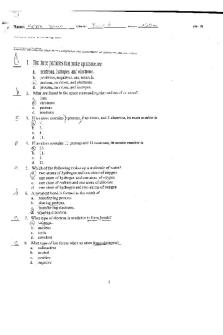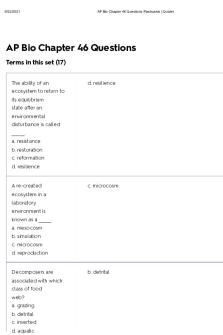AP BIO Heredity Questions and Answers PDF

| Title | AP BIO Heredity Questions and Answers |
|---|---|
| Author | Iman Shahid |
| Course | AP Biology |
| Institution | Sayreville War Memorial High School |
| Pages | 6 |
| File Size | 87.6 KB |
| File Type | |
| Total Downloads | 73 |
| Total Views | 144 |
Summary
AP Biology questions on heredity and answers to go with those questions....
Description
Iman Shahid AP BIOLOGY NJCTL QUESTION HEREDITY UNIT
1. Dominant traits are alleles that show up more often compared to the recessive trait. The dominant allele trait can show up in the homozygous dominant and heterozygous. The recessive trait will only show up in the homozygous recessive. 2. Heterozygous means two different alleles, such as Rr. Homozygous means two of the same alleles such as RR or rr. 3. An allele is alternate for of a gene. Alleles can be either dominant or recessive and are represented as a capital letter or lowercase letter respectively. 4. Genotype is the genetic makeup of an organism. Phenotype is the outward appearance of the organism. 5. A test cross is performed by mating a plant that is homozygous recessive with an unknown individual. If the organism is homozygous recessive all the offspring will look like the known recessive. If the results are half like one parent and half like the other parent, than the unknown is heterozygous. If the traits exhibited are like the unknown individual than it is homozygous dominant. 6. Tt x tt 7. Both parents would be heterozygous, therefore the chance would be ¼. 8. The law of independent assortment is when different genes that control different traits separate independently in the formation of gametes.
9. Monohybrid cross involves genetic crosses that involve a singe trait from both parents. A dihybrid cross involves two different traits. 10. The children would be expected to be ¼ brown eyed tasters, ¼ brown eyed non-tasters, ¼ green eyed tasters and ¼ green-eyed nontasters. 11. Huntington’s Disease is a degenerative brain disorder, that eventually takes away a persons ability to walk, think, talk and reason. Huntington’s disease is a result of a dominant allele. 12. Chance of brown eyes is ¾, blue eyes is ¼. 13. ¼ SS, ½ Ss, ¼ ss therefore the phenotypes would be ¾ smooth and ¼ rough 14. Yellow would be dominant. 15. Both parents are heterozygous and the child received the recessive allele from each parent. Parent’s genotype Tt, phenotype tongue roller: child genotype tt and phenotype non-tongue roller. 16. ½ DD and ½ Dd for the first cross. ¼ DD and ½ Dd for the second cross. ¼ will die. 17. Pink is dominant. Parents are both heterozygous for pink. 18. Complete a test cross. Cross two red and two yellow to determine if both are homozygous. Cross the red with the yellow to create the heterozygous. Cross the one whose color does not show up with the heterozygous, if the result is half red and half yellow you know the yellow is recessive and the red is dominant. 19. The grey rabbit is Ggw and the chinchilla is Ggw 20. Chicken #1 – FfPp, Chicken #2, FFPP, Chicken # 3 FfPP, Chicken #4 – FfPp 21. The man would be Bb. Therefore, the possible offspring would be ½ Bb and ½ bb. 22. A. ½ YY, ½ Yy
B. ¼ YY, ½ Yy, ¼ yy C. ½ Yy, ½ yy 23. The effects of both alleles can be detected in a diploid heterozygous with two different alleles of a gene. The heterozygous gives a different phenotype than homozygous dominant or homozygous recessive. One example is Red four o’clock flower being mated with a white four o’clock gives a pink four o’clock. 24. ½ will have red flowers; RR, ½ will have pink flowers; Rr. Next cross: all will have pink flowers Rr. Last cross ¼ will have red RR, ½ will have pink Rr, and ¼ will have white rr. 25. Pleiotropy involves a situation where a single gene influences more than one phenotypic characteristic. Polygenic inheritance involves a pattern of inheritance in which the interaction of two or more similar genes determines the phenotype. 26. White, tabby and black in 12:3:1 ratio 27. Type O blood type lack the A and B antigens they can be given to any one. Type AB blood does no have the neither anti-A nor anti-B antibodies, therefore they can receive any blood because they don’t have the antibodies to reject them. 28. For the son, 100%. For the daughter none will be colorblind. 29. The chance is ½ for both. 30. Genes that are located on the same chromosome and are near one another tend to be inherited together. 31. Genes that are closer together on the same chromosome have a lesser chance of recombination.
32. In polygenic inheritance the same phenotype is controlled by two or more different genes with various alleles. Inheritance by a single gene is controlled by one set of alleles. 33. Epistasis is where the alleles of one gene overrides the expression of one or more different genes. In guinea pigs hair color produces black or brown. The expression of the B – black gene is controlled by a different gene C for color. For any color, black or brown to be expressed they must have a CC or Cc, otherwise the guinea pig will be albino. 34. All females will have normal vision, ½ males will be color blind, ½ normal color vision. 35. A recessive allele carried on the X chromosome is lethal in males. XLXl x XLY = ¼ XLX , ¼ X LXl, XLY, ¼ XlY (lethal) 36. 3/8 red eyes/ normal, 3/8 black eye/ normal, 1/8 red /vestigial, 1/8 black /vestigial 37. Recombination occurs when homologues on each chromatid cross over, break of and exchange places. 38. X – 8% -- Z -3% -Y ----------12%------39. ADBC 40. A null hypothesis is no difference between what is being tested and what is accepted and any difference is due to chance. 41.
Blue Green Orange Yellow
Observed 22 17 54 27 Total = 120
Expected 30 30 30 30 Chi = 27.2
Df = 4-1 = 3. At 0.05 we see a p value of 7.82 our value of 27.2 is much greater so we reject our null hypothesis meaning there is a color preference. 42. 1/6 x 1/6 x 1/6 x 1/6 x 1/6 = 1/7776 43. 32 different combinations. 44. Observed #
Expected #
(observedexpected)2/expected
Purple and smooth Purple and wrinkled Yellow and smooth Yellow and wrinkled Df = n – 1
283 81 79 24 467 total or 4 – 1 = 3
262 88 88 29
1.68 0.56 0.92 0.86 Total =4.03
Chi-square = 7.82 our value of 4.03 is less indicating that there is a good fit between our data and the expected values. 45.
Group A Group B
Observed with
Expected with
Sum of (observed-
cavities 227 186
cavities 250 250
expected)2/expected
2.12 16.38 18.50 Df = n-1 probability at 0.05 would be 3.84; since our value is greater we reject the null hypothesis. 46. ½ x 1/4 x ½ x ¼ = 1/64 47. 1x1x1/2x1/2 = ¼ 48. Sexual Reproduction provides more opportunity for genetic variability in the offspring. There is also a greater chance of producing more fit offspring do to sexual cycles limiting when a species can produce offspring....
Similar Free PDFs

AP Bio Proteins
- 1 Pages

AP Bio Mendelian Genetics
- 3 Pages

AP. Bio. Test - test
- 4 Pages

AP Bio Linked Genes
- 3 Pages

AP Bio Photosynthesis Lab
- 1 Pages

AP Bio Nondisjunction
- 1 Pages

AP Bio Cell Cycle
- 3 Pages

AP Bio Transpiration Lab
- 24 Pages

Ap Bio Photosynthesis Worksheet
- 2 Pages

AP Bio Speciation
- 4 Pages

AP Bio Review - Bio lab practice
- 2 Pages
Popular Institutions
- Tinajero National High School - Annex
- Politeknik Caltex Riau
- Yokohama City University
- SGT University
- University of Al-Qadisiyah
- Divine Word College of Vigan
- Techniek College Rotterdam
- Universidade de Santiago
- Universiti Teknologi MARA Cawangan Johor Kampus Pasir Gudang
- Poltekkes Kemenkes Yogyakarta
- Baguio City National High School
- Colegio san marcos
- preparatoria uno
- Centro de Bachillerato Tecnológico Industrial y de Servicios No. 107
- Dalian Maritime University
- Quang Trung Secondary School
- Colegio Tecnológico en Informática
- Corporación Regional de Educación Superior
- Grupo CEDVA
- Dar Al Uloom University
- Centro de Estudios Preuniversitarios de la Universidad Nacional de Ingeniería
- 上智大学
- Aakash International School, Nuna Majara
- San Felipe Neri Catholic School
- Kang Chiao International School - New Taipei City
- Misamis Occidental National High School
- Institución Educativa Escuela Normal Juan Ladrilleros
- Kolehiyo ng Pantukan
- Batanes State College
- Instituto Continental
- Sekolah Menengah Kejuruan Kesehatan Kaltara (Tarakan)
- Colegio de La Inmaculada Concepcion - Cebu




